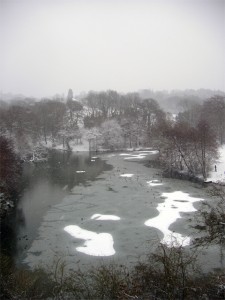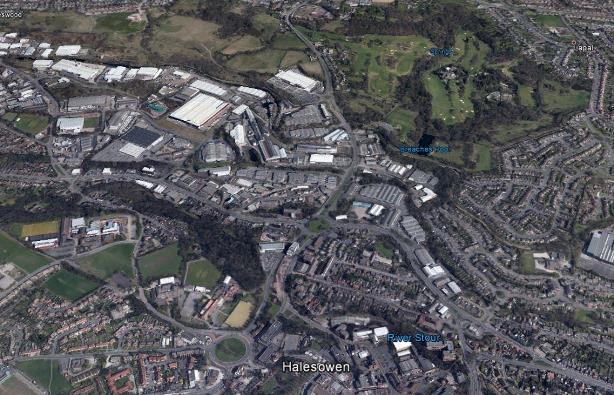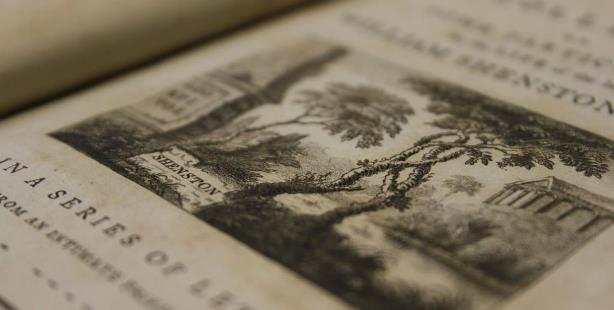Written by Adam Koszary, Project Officer for Our Country Lives.
How interdependent are town and country? How do they rely on each other, and where does one end and the other begin? It is a theme we’re exploring in great detail for Our Country Lives and, considering around 90% of English people live in urban areas, a very relevant one. I wasn’t expecting, however, that my own town would ever factor into the discussion. Halesowen is part of the Dudley borough in the West Midlands. It is decidedly post-industrial and urban, despite sitting on the edge of a greenbelt. However, it also has a wooded, scenic park at its heart which began as one of the first landscaped estates in the country, perhaps even the world. Begun in 1743, Leasowes Park has managed to weather industrial revolution (including having a canal run through it), its encirclement by the West Midlands conurbation, a golf course development and the infamous town planners of the mid-20th century.
It was designed and built by William Shenstone (1714-1763), who began modelling the Leasowes estate on scenes inspired by pastoral poetry when he inherited the land as a dairy farm. His ashes are now contained in a sizable urn displayed in the Norman parish church of St John, and for his trouble also has a Wetherspoons named after him. Shenstone was among the first to conceive of a garden as a curated journey, pacing walks around the estate with built features and enriching the views with quotations from classical authors as well as his own writings (we have collections of his work in the University’s Special Collections). His Elegy XXI, written in 1746, could very well have reflected his vision for Leasowes:
Lord of my time, my devious path I bend
Thro’ fringy woodland, or smooth-shaven lawn,
Or pensile grove, or airy cliff ascend,
And hail the scene by Nature’s pencil drawn.[1]
Leasowes still contains fringy woodland, smooth-shaven lawns and pensile groves, but he combined this natural landscaping with romantic structures such as urns, bridges and even a ruined Priory, constructed from the rose-red sandstone nicked from the ruins of Halesowen Abbey. Visitors came from far and wide to visit this landscape garden, helped in part by printed engravings which attracted figures such as Prime Minister William Pitt, Benjamin Franklin and American president Thomas Jefferson. A friend of Shenstone wrote:
‘Born to a very small paternal estate, which his ancestors cultivated for a subsistence, he embellished it for his amusement; and that in so good a taste, as to attract the notice, not only of the neighbouring gentry and nobility, but almost of every person in the kingdom, who either had, or affected to have, any relish of rural beauties: so that no one came to see the noble and delightful seat of Lord Lyttelton at Hagley, who did not visit with proportionable delight the humbler charms of the Leasowes.’[2]
 The estate also had a profound effect on the burgeoning English landscape style, and particularly so on Lancelot ‘Capability’ Brown, whose tercentenary we will be celebrating in 2016. Landscape Architecture holds particular interest for MERL as we hold the Landscape Institute’s archives. The Institute was founded only in 1929, and work to improve the planning and design of the urban and rural landscape, so we’re delighted to hold their fascinating archives and library.
The estate also had a profound effect on the burgeoning English landscape style, and particularly so on Lancelot ‘Capability’ Brown, whose tercentenary we will be celebrating in 2016. Landscape Architecture holds particular interest for MERL as we hold the Landscape Institute’s archives. The Institute was founded only in 1929, and work to improve the planning and design of the urban and rural landscape, so we’re delighted to hold their fascinating archives and library.
Leasowes remains a popular attraction for the local area, providing an oasis of natural calm sandwiched between dual carriageways. It was on one of these dual carriageways recently when I had the juxtaposed views of the Black Country sprawl spread out on my left, and on my right a horse grazing in woodland. Horses are a recent addition thanks to a recent HLF grant that has brought the park back to its original form, restoring paths, cascades and reintroducing cattle as well as horses.
It is in this way that the Leasowes estate encapsulates for me the strange relationship between town and country. Shenstone’s designs are an idealised, man-made manifestation of landscape, and one which pre-empts the long development of English gardens and country estates. When built, Leasowes was an escape into pastoral fantasy but now, trapped in a town, it is for many people the only countryside they know. The idea of the countryside can mean many things to different people – it could be a place of work, a place of relaxation, a place of sport; it could be down the road, it could be half an hour away; it could be local farmland, it could just be a local park; and for some few people, it is something they have only ever seen on television. Exploring what the countryside means to different people through how we view and perceive it is something we are exploring in great detail as part of Our Country Lives, and for me Leasowes Park is a perfect case study.
[1] Shenstone, W., ‘Elegy XXI’, The Poetical Works of William Shenstone, Esq., London: Alexander Donaldson (1775).
[2] Graves, R., Recollection of some particulars in the life of the late William Shenstone, Esq., London: J Dodsley (1788).






What a rich and thought-provoking post. ‘The Leasowes’ was an example of a particular type of landscape gardening, the ‘ferme ornée’ (ornamental farm). This was popularized by the garden writer and theorist Stephen Switzer. The idea was to develop a form of ‘affordable gardening’ for country gentlemen, combining agricultural with aesthetic features arranged along a carefully circumscribed route. Switzer was responsible for laying out Caversham Court, just across the Thames from here, in 1718. Interestingly, Whiteknights itself (now the University of Reading’s main campus) was at one time a celebrated ferme ornée, when owned by the Duke of Marlborough. Landscape gardening and poetry were closely connected in the c.18th, as in Shenstone’s case, as was landscape painting (hence ‘picturesque’ views). These are some of the themes of the third year ‘special subject’ I teach as part of the Department of History’s undergraduate degree programmes.
Shenstone lived in “The Laurels”, the house “next door” to me. We live next to the park and it’s a special place. There’s one particular viewpoint with a view over the lake that will always bring back memories of my dear old Dad.
Coincidentally, my daughter married a distant relative of Thomas Attwood, the Great Reformer, who was a later owner of Shenstone’s house.
Well done Adam. Your post makes an interesting read, and good to hear that the Leasowes landscape is now fully restored!
I walked its landscape in 2007, I think, when the restoration portacabins were pitched in the car park. I was very impressed with the interest and dedication of the team in its restoration. Although the landscape has been sliced up by the golf course, there is enough for everyone to enjoy the diversity of its landscape and imagine Shenstone taking tours around it in a specific way that the visitors would encounter his poetry pinned to trees on parchment in Virgil’s Grove. Ian Hamilton Findley’s seat sits comfortably within the dell, and a nice homage to the Halesowen bard.
Jeremy, great to hear that you are teaching elements of garden history to third year undergraduates in the Department of History! Will there be final year theses emerging on historic landscapes utilising the Landscape Institute’s collections at Merl?
Good idea re 3rd year dissertations using Landscape Institute collections. Will do my best to promote this within the Department. Thanks, Jeremy
Great!
Do connect with the landscape Institute Archivist and her Senior Assistant to get an overview of the collection/Library content, and an introduction/seminar to the material for your students in MERL Special Collections. I am sure you will find them very enthusiastic to nurture your students interests.
Depositing a copy of the students investigations with enhance the collection too!
Good luck.
Wonderful insight Andy; enriching to what has already been written on The Leasowes. Have you got any photos of your Dad at The Leasowes and your son-in-law? These would be interesting developments to how the landscape/house was used and developed.
The article is quite interesting, but may I correct a few errors in it. I was the Archaeological Officer for Dudley Metropolitan Borough Council and was responsible for monitoring the excavations done on Shenstone’s landscape garden at The Leasowes in the 1990’s. Since my retirement I have been doing a PhD at the University of Birmingham on Shenstone’s landscape garden design and have obviously picked up a few items of interest. Firstly Koszary’s ‘smooth shaved lawns’ are as Wilson states part of a golf course and the work that has been done creating it has demolished hedges and smoothed out the fields in the landscape. Second, it was not the first landscape garden in this country or for that matter in ‘the world’ and Launcelot Brown’s style of gardening was very different to Shenstone’s. Thirdly, Shenstone’s remains are not in the urn in St. John the Baptist’s Church, but buried in a grave a few feet from the entrance to the church door, and his landscape garden has not been brought back to its original form. That would take a great deal of money and the disappearance of the Golf course. The features that were recreated were some of the paths, the Dripping Fountain and the High Cascade, all in the north brook. In fact this latter feature was a creation of the landscape architect who worked on the estate in the 1990’s and looks nothing like Shenstone’s original cascade shown in an engraving in the British Library.
Great insights John! Gardens/landscapes are forever evolving and influencing in unexpected ways these layers of history enrich the experience of Shenstone’s original concept; interpreting and communicating these layers is key. Good luck with your PhD journey; will there be a postscript on the current restoration at The Leasowes?